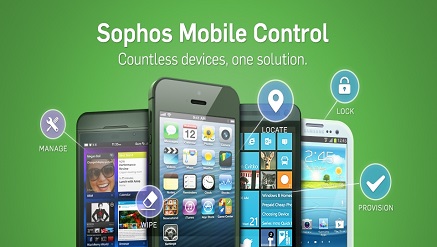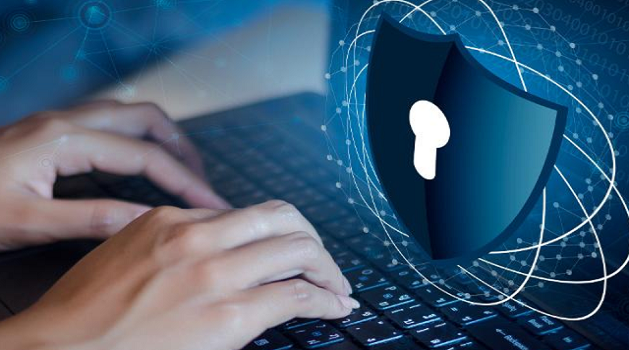E-Business
Sophos Delivers Easy-to-Use Security Solutions for Enterprise Mobility Management

Sophos, a global leader in network and endpoint security, today announced the availability of Sophos Mobile Control 6.0, which now includes Sophos Secure Email, a container solution that isolates and secures business data from personal information on devices.
Sophos Mobile Control 6.0 also enhances data protection capabilities and allows IT managers to oversee devices used throughout their organization through a simple interface and intuitive workflows.
Within Sophos Mobile Control 6.0 is Sophos Secure Email, a personal information management (PIM) container solution for email, calendar and contacts.
Personal and corporate data can be separated, allowing organizations to manage business data security while enhancing user privacy.
IT administrators can remotely provision email to employee mobile devices across popular platforms, including iOS, and multiple Android versions.
Also new to version 6.0 is Sophos Secure Workspace which includes Corporate Browser to facilitate safe access to frequently used business productivity sites and applications.
Sophos Secure Workspace enables employees to seamlessly access and collaborate on the documents they need, when they need them, in a secure manner.
Users also can control levels of access and publishing rights for various cloud storage providers like Dropbox, Google Drive, Microsoft OneDrive and Egnyte.
For additional protection, users now can securely move documents and data between mobile devices, cloud storage and corporate endpoints as Sophos SafeGuard file encryption is built in.
With the continued growth in mobile malware, the ability to detect and quarantine infected devices is a growing priority for enterprise mobility management (EMM). In fact, more than 95 percent of attacks today involve harvesting credentials from customer devices and using those stolen credentials to log in to web applications, according to Verizon 2015 Data Breach Investigations Report.
Device security is especially difficult to manage in mid-size enterprises that have widely distributed workforces, yet are resource-stretched.
A September 2015 CompTIA study, Managing the Multi-Generational Workforce, showed that nearly half (46 percent) of small and mid-sized businesses have now fully adopted BYOD as a standard practice, as opposed to only 28 percent of large enterprises.
“It’s too easy for employees to unknowingly download dangerous apps that expose valuable corporate data, or worse, provide an open path to business networks,” said Dan Schiappa, senior vice president and general manager of Sophos Enduser Group.
“Providing management, anti-malware and data protection for mobile devices is just as important as it is for laptops or any other corporate asset – the devices are small but they can be hacked and cracked just like any PC.
Balancing the levels of productivity and access demanded by users today with the growing need for tighter data security requires the ability to manage and protect. Having an enterprise mobility management solution with integrated security is becoming a critical need to organizations of any size.”
Sophos Mobile Control 6.0 also detects jail-broken or rooted devices, plus malware and potentially unwanted applications (PUAs).
The product blocks infected or non-compliant devices from entering the corporate network and automatically blocks malicious or undesirable websites.
A recent analysis by third party AV-Test confirmed that Sophos Mobile Control 5.5 detected 100 percent of known Android malware applied during the test period. All of this is done behind the scenes to users so that productivity isn’t sacrificed and critical, confidential data remains private and safe.
Sophos Mobile Control 6.0 is available now from the global network of Sophos certified partners.
More than 100 million users in 150 countries rely on Sophos’ complete security solutions as the best protection against complex threats and data loss.
Simple to deploy, manage and use, Sophos’ award-winning encryption, endpoint security, Web, email, mobile and network security solutions are backed by SophosLabs – a global network of threat intelligence centers.
E-Business
Half of Global Companies Build SOCs to Enhance Cybersecurity, with a Focus on Human Expertise

Among the primary reasons for establishing a Security Operations Center (SOC) are strengthening cybersecurity posture, enabling faster detection and response and gaining a competitive edge.

Interestingly, despite the increasing demand for automated cybersecurity solutions, businesses rely on skilled security professionals to make key decisions, as human expertise remains essential for effective security management.
A Security Operations Center (SOC) is a dedicated organisational unit responsible for continuous monitoring and safeguarding of a company’s IT infrastructure. Its core mission is to proactively detect, analyse and respond to cybersecurity threats.
To identify the main drivers, strategic priorities, and potential challenges in SOC planning and implementation, Kaspersky has conducted a comprehensive global study involving senior IT security specialists, managers and directors from companies with 500 or more employees.
All participants operate without a SOC but have plans to establish one in the near future. The study spans 16 countries across APAC, META, LATAM, Europe, and Russia, providing valuable insights into the emerging trends and best practices in SOC development worldwide.
The findings of the research reveal that 50% of companies intend to establish SOCs to strengthen their cybersecurity posture, and 45% are motivated by the need to address increasingly sophisticated and dangerous threats.
Other drivers include budget optimisation, the necessity for faster detection and response, and the expansion of software, endpoints and user devices – factors that demand more comprehensive and layered security measures.
These are cited by 41% of organisations. Additionally, 40% seek better protection of confidential information, 39% aim to meet regulatory requirements and one-third (33%) expect SOC capabilities to provide a competitive edge. Larger enterprises tend to cite each of these reasons more often, reflecting the broader operational and regulatory pressures they experience.
Continuous monitoring becomes the leading SOC requirement
Among the key functions organisations plan to delegate, 24/7 security monitoring leads at 54%. This around-the-clock vigilance enables early detection of anomalies, prevents escalation and sustains cyber resilience in real-time. This demand highlights a strategic requirement for proactive risk management, as organisations aim to defend against persistent threats that can strike at any moment.
Companies intending to fully outsource SOC operations show a stronger interest in applying “lessons learned” methodologies, whereas those developing internal SOCs focus more on access management to maintain tighter control.
Human expertise drives SOC technology choices
While SOCs use advanced technology, the choices made by organisations show that human analysts are very important. Among the solutions that organisations plan to include in SOC are – Threat Intelligence Platforms (48%), Endpoint Detection and Response (42%) and Security Information and Event Management systems (40%) – sophisticated solutions that automate data collection and reduce operational load, however, they depend heavily on skilled security professionals who provide critical context, interpret complex findings and make final decisions when guiding appropriate responses.
Other solutions chosen include Extended Detection and Response (38%), Network Detection and Response (37%) and Managed Detection and Response (33%). Large enterprises tend to adopt more technologies (5.5 per SOC on average), while smaller ones integrate fewer (3.8).
“To successfully build a SOC, companies must prioritise not only the right mix of technology but also the careful planning of processes, clear goal-setting and effective resource distribution.
“Well-defined workflows and continuous improvement are essential to ensure that human analysts can focus on critical tasks, making the SOC a proactive and adaptable component of their cybersecurity strategy,” comments Roman Nazarov, Head of SOC Consulting at Kaspersky.
E-Business
Nigerian Terra Industries Secures $11.8m for Expansion

Terra Industries, a Nigerian defence technology startup, has raised $11.75 million to expand its development of defensive systems that protect critical facilities across Africa.

The fundraising round was led by Silicon Valley venture firm 8VC, which was founded by Palantir co-founder Joe Lonsdale.
Other investors in the round include Valour Equity Partners, Lux Capital, SV Angel, and Nova Global, as well as African-focused funds Tofino Capital, Kaleo Ventures, and DFS Lab.
Terra Industries, founded in Abuja by Nathan Nwachuku and Maxwell Maduka, provides multi-domain security solutions for both air and land. Its solutions are intended to detect and respond to threats including terrorism, sabotage, and armed attacks on infrastructure.
The company’s product portfolio includes surveillance drones, ground-based robotic systems, and fixed monitoring towers deployed around sensitive locations.
Co-founder and CEO Nathan Nwachuku said the company has now fully embraced its identity as a defence-focused startup, citing the growing urgency of security challenges across Africa.
He said safeguarding critical infrastructure from terrorist threats has become unavoidable.
Nwachuku argues that protecting Africa’s infrastructure requires a different approach, one that combines local manufacturing, end-to-end system control, and software capable of independently identifying and responding to threats over large areas.
The company aims to position itself as a defence prime, similar to the role played by firms such as Anduril Industries and Palantir in the United States.
Nwachuku also disclosed that the company had earlier raised $800,000 in pre-seed funding.
With the new funding, Terra plans to increase manufacturing capacity within Africa, establish additional defence production facilities, and expand its artificial intelligence and software teams.
While software offices are planned for San Francisco and London, the company said manufacturing operations will remain on the continent.
E-Business
Kaspersky Warns Telecom Threats from 2025 will Carry into 2026 as New Technology Adds New Risk

Kaspersky Security Bulletin reviews what shaped telecom cybersecurity in 2025 and what is likely to persist in 2026. Advanced Persistent Threat (APT) activity, supply-chain compromise, DDoS disruption and SIM-enabled fraud continued to pressure operators in 2025, while newer technology deployments introduce additional operational risk.

In 2025, telecom operators faced four broad threat categories. Targeted intrusions (APTs) continued to focus on gaining stealthy access to operator environments for long-term espionage and leverage through privileged network positioning.
Supply chain vulnerabilities remained an entry point: telecom ecosystems rely on many vendors, contractors and tightly integrated platforms, so weaknesses in widely used software and services can provide a path into operator networks. Finally, DDoS remained a practical availability and capacity problem.
Kaspersky Security Network showed that last year, between November 2024 and October 2025, 12,79% of users in the telecommunications sector encountered web threats and 20,76% faced on-device threats. 9,86% of telecom organisations worldwide experienced ransomware.
At the same time, the telecommunications sector is moving from rapid technological development to broad implementation — and the report argues that this shift creates new opportunities and new operational risks for 2026.
Kaspersky highlights three areas where technology transitions could introduce disruption if rolled out unevenly or without strong controls: AI-assisted network management, where automation can amplify configuration errors or act on misleading data; post-quantum cryptography transitions, where rushed deployment of hybrid and post-quantum approaches could cause interoperability and performance issues across IT, management and interconnect environments; and 5G-to-satellite integration (NTN), where expanding service footprints and partner dependencies introduce new integration points and potential failure modes.
“The threats that dominated 2025 — APT campaigns, supply chain attacks, DDoS floods — aren’t going away. But now they intersect with operational risks from AI automation, quantum-ready cryptography, and satellite integration.
Telecom operators need visibility across both dimensions: maintaining strong defences against known threats while building security into these new technologies from day one. The key is continuous threat intelligence that spans from endpoint to edge to orbit,” said Leonid Bezvershenko, senior security researcher at Kaspersky Global Research & Analysis Team.

 E-Financial3 days ago
E-Financial3 days agoWema Bank Upgrades ALAT Banking App

 General News3 days ago
General News3 days agoFirm Launches AI-powered Platform to Simplify New Tax Laws

 Telecom3 days ago
Telecom3 days agoX Suspends Twitter Account for Rules Violation

 E-Business3 days ago
E-Business3 days agoStudy Reveals 88.5% of Phishing Attacks Focus on Stealing Account Credentials

 General News2 days ago
General News2 days agoPalmPay, Premier Cool to Reward 10,000 Nigerians with ₦100m in “10k for 10k Campaign”

 News2 days ago
News2 days agoNigeria, Others Lag Behind as Egypt Tops Africa in AI Readiness

 E-Financial2 days ago
E-Financial2 days agoEcobank Joins Trillion-naira Club for the First Time in 20 Years

 E-Business2 days ago
E-Business2 days agoKaspersky Warns Telecom Threats from 2025 will Carry into 2026 as New Technology Adds New Risk















